During a TeamViewer (Classic) remote control session, the TeamViewer (Classic) Remote Session Toolbar appears on the local computer's top screen.
This article explains all available toolbar features in a connection from a Windows device.
📌Note: For connections from macOS, please see this article.
This article applies to all TeamViewer (Classic) users in connecting Windows to Windows devices.
The toolbar's functions
This is the main view of the Windows Remote control toolbar.

The following chapters describe each of the different features found in the remote control toolbar.
X - Closing the session

With this button, you can close the remote session. If a lock symbol is visible, it means that the Windows session of the remote device will be locked after closing the TeamViewer (Classic) session.
📌Note: This function can be changed in the TeamViewer (Classic) settings of your local computer under Advanced ➜ Advanced settings for connections to other computers ➜ Lock remote computer. You can choose between Always, Never, and Automatic.
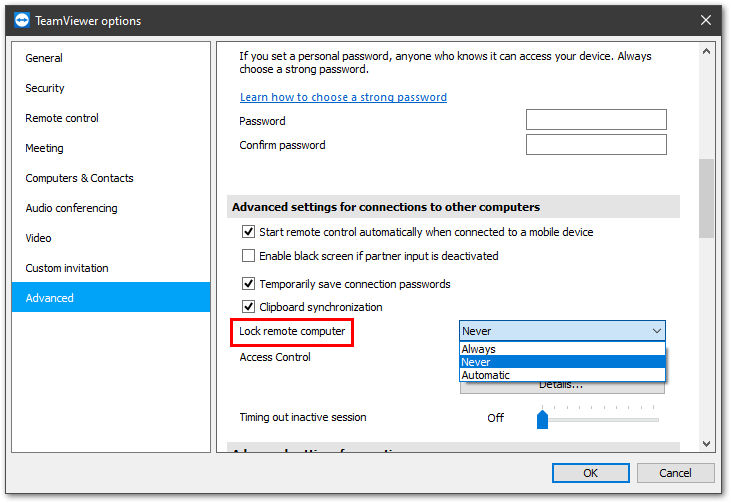
- Always: At the end of every TeamViewer (Classic) session, the remote device will be locked, regardless of the device's status before the session
- Never: At the end of every TeamViewer (Classic) session, the remote device will remain unlocked and visible, regardless of the device's status before the session
- Automatic: If the remote device was locked before the session, the device will again lock at the end of the session. If the device was unlocked before the session, it would remain unlocked
📌Note: It is always recommended to end a session using the X in the remote control toolbar. It is not recommended to end sessions via the Windows closing X found in the upper right corner of the session.
Home

The home button pulls up the General Information tab of the Extended Remote Device Dashboard.
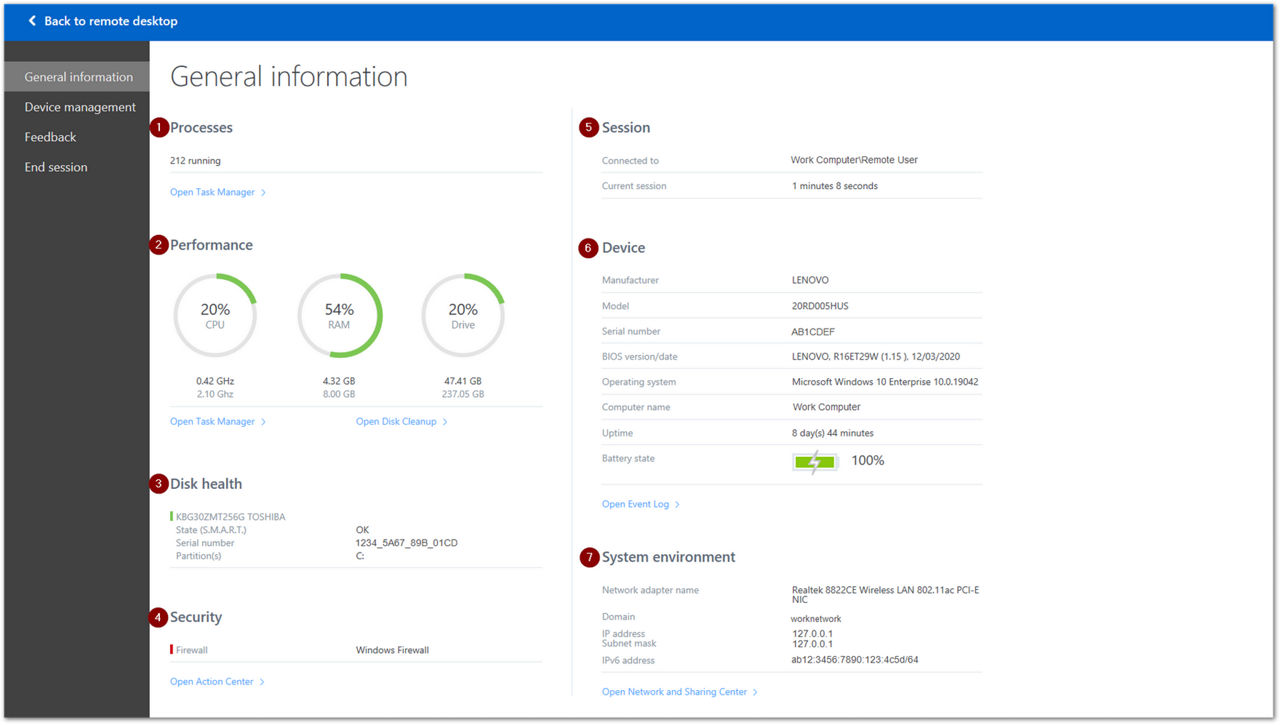
This provides useful information about the remote device:
- The total number of processes running on the remote device
- The Performance of the device
- Disk health information
- Security information
- Session information
- Device information
- System environment
Actions

The Actions menu provides quick access to many features in controlling the remote device.

Session
- End Session
- End session and lock remote computer can be found in the drop-down menu below End Session
- Leave Note
- Leaves a note for the remote user after the session ends
Automation
📌Note: Use of the automation feature requires a Premium License or higher
- Access to all available QuickSteps options
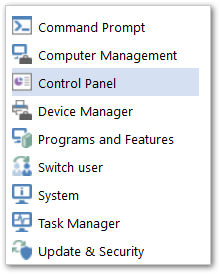
- Scripts
- Allows execution of remote scripts during the session
💡Hint: For more information about how to execute scripts, please read this article: Execute scripts remotely
Windows Options
- Lock
- Offers multiple options to affect the current user on the remote machine
- Lock now locks the remote computer immediately
- If Lock on session end is checked, the device will be locked at the end of the TeamViewer (Classic) session
- Sign out on remote computer signs the current user logged into the remote machine out, bringing the session back to the login screen
- Lock now locks the remote computer immediately
- Offers multiple options to affect the current user on the remote machine
- Reboot
- Reboots remote computer immediately
- Reboot in safe mode can be found in the drop-down menu below Reboot
- Reboots remote computer immediately
Remote Interaction
- Send Ctrl + Alt + Del
- Sends Control/Alt/Delete command to the remote machine, allowing access to Task Manager and other services
- Clipboard
- Offers access to the shared clipboards in a TeamViewer (Classic) session
- If Use shared clipboards is checked, both device's clipboards are automatically synced
- Send Clipboard sends contents of controllers clipboard to the remote device
- Get Clipboard retrieves contents of the remote device's clipboard to the controller device
- Offers access to the shared clipboards in a TeamViewer (Classic) session
- Send key combinations
- Forwards key combinations (such as Win+E, Ctrl+P, etc.) to the remote device, allowing the use of all keyboard shortcuts remotely
- Disable remote input
- Disables the remote device's keyboard and mouse, preventing interruption during maintenance work or other remote connection needs
- Show black screen
- the remote computer's screen gets immediately hidden by the TeamViewer security image
Participants
- Invite additional participants
- Invite additional TeamViewer users into the same remote session when connected to a remote device
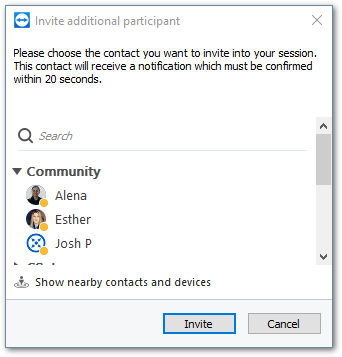
📌Note: You can only invite registered users in your Computers & Contacts list.
Information
- Remote System Information
- Hardware/OS information, similar to what is found in the Extended Remote Device Dashboard
- Connection Information
- Information related to the current connection between the two devices
- Duration of connection
- Display resolution
- Remote partner's TeamViewer version
- Local and Remote Fingerprint
- Information related to the current connection between the two devices
- Remote Update
- Installs the latest version of TeamViewer on the remote device, if an update is available
💡Hint: For more information on how to update TeamViewer (Classic), please see the following article: Update TeamViewer (Classic)
View

The View menu offers quick access to options and capabilities to optimize the current TeamViewer (Classic) session.

Scaling
- Best fit
- Provides a balance between the remote device's and controller device's current display settings
- Original
- Displays the current screen resolution of the remote device
📌Note: If there is a large difference between the two devices, the remote screen may appear too large or too small to view correctly when set to Original
- Scaled
- Stretches the remote device display to get the best viewing size on the controller computer.
Quality
- Auto select
- Automatically calculate the best balance between Optimize quality and Optimize Speed
- Optimize Speed
- Optimize the fluidity of the remote session, allowing for a more responsive control
📌Note: The graphic quality of the remote session may be negatively affected when using Optimize Speed
- Optimize quality
- Optimize the graphic quality of the remote session, allowing for a more accurate display of the remote device's graphics
📌Note: The connection fluidity of the remote session may be negatively affected when using Optimize Quality
Monitors
- Switch between remote device's monitors by clicking the monitor number

- Monitors as individual tabs to view the remote device's separate monitors on separate tabs in the same remote control window
💡Hint: For more information on how to view multiple monitors with TeamViewer (Classic), please see the following article: Use multi-monitor support on Windows
Performance
- Screen Resolution
- Change the current screen resolution of the remote device
📌Note: Available resolutions depend on the remote device's current options. TeamViewer cannot provide any resolutions not currently provided by the remote device's hardware/OS
- Hide Wallpaper
- Replaces the remote device's wallpaper with a blank black overlay
- Show remote cursor
- The mouse cursor of the remote computer will also be visible to the controller during the connection
View Options
- Refresh screen
- Sends a request to update the graphics display of the remote device
- It can help if the screen appears frozen in the connection or many tasks are running on the remote machine
- Sends a request to update the graphics display of the remote device
- Select single window
- Instead of viewing the entire display of the remote device, view an individual screen or app
- When selected, a crosshair will appear, which is used to select the desired window to focus on
- Instead of viewing the entire display of the remote device, view an individual screen or app
- Show sessions in tabs
- When connected to multiple devices, each connection appears as a separate tab in the same TeamViewer (Classic) window
Full Screen
- Switch to Full screen
- The TeamViewer (Classic) session will appear in full screen on the controller computer. To exit full-screen mode, go back to the View tab and click on Leave full screen
Communicate

The Communicate menu provides different methods of communication with the connection partner in a remote control session.

Computer Sound
- Computer Sound
- Allows the audio output of the remote device to route through the audio output of the controller's device
Control
- Switch sides with partner
- Reverses roles of the connection - the remote user can now view and control the local user's computer
Conference Call
- Call via internet
- Using Voice over IP (VoIP), a call will be established via the internet. The device's audio inputs and outputs will be used
- Call by telephone
- When selected, Phone call details will appear to the right and will bring up a new menu
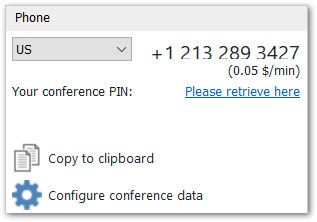
Using the phone number(s) provided, a conference call can be made
📌Note: A charge is incurred using the provided conference call phone numbers. This rate will vary based on the location
- Custom conference call numbers can also be used in place of the service provided by TeamViewer (Classic). This can be configured by selecting Configure conference data
Chat & Video
Whiteboard
- Annotate
- Enables the whiteboard function
💡Hint: For more information on how to use the Whiteboard, please see the following article: Use Whiteboard in Remote Control
Files & Extras
The Files & Extras menu provides access to additional services from within each remote control session.
- Activate TeamViewer Printing
- Enables remote printing
💡Hint: The print driver must be installed to use remote printing with TeamViewer. For more information about remote printing, please see the following article: Remote printing with TeamViewer (Classic)
VPN
- Start VPN
- Enables the TeamViewer (Classic) VPN.
💡Hint: The VPN driver must be installed to use TeamViewer (Classic) VPN. For more information about the TeamViewer (Classic) VPN, please see the following article: About TeamViewer (Classic) VPN
Screen Recording
- Take screenshot
- Creates a screenshot of the current display of the remote device
- Start session recording
- Begins recording of the remote session
📌Note: If Record partner's video and VoIP is checked, a prompt will appear asking the remote device to allow their camera and microphone to be recorded. If no confirmation is given, the recording will still begin but not contain the remote device's video or VoIP.
💡Hint: For more information about how to record a TeamViewer (Classic) session and how to convert the recording, please see the following article: Record TeamViewer (Classic) session or meeting
Additional Features
Comment
The Comment button provides the ability to notate connections. This button produces a pop-up window where details regarding the connection can be entered.
Comments entered here can be retrieved in the Management Console under Connection Reports. Comments for each session will appear under the Notes column
💡Hint: For more information about incoming and outgoing connections reports, please see the following article: Connection Reports
Feedback
The Feedback button offers you to send your feedback to the TeamViewer Product Team during any remote control session.
You can provide the following information from this form:
- Feature requests or comments
- Email address
📌Note: While the TeamViewer Product Team reads all feedback, we cannot guarantee that any specific feedback request will or will not be answered. Regardless, we thank you for your continued support!
- TeamViewer (Classic) logs
- This will automatically attach the logs from the device to your feedback
- Screenshot








